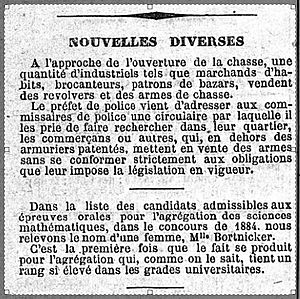Liouba Bortniker facts for kids
Liouba Bortniker (born in 1860) was a brilliant mathematician from the Russian Empire. She later became a French citizen. Liouba made history by being the first woman to earn a special high-level teaching degree in mathematics called an agrégation. She also won the very first Peccot–Vimont prize from the Collège de France, a famous school. On top of that, she was the first woman to publish her work in a major science journal called Comptes rendus de l'Académie des Sciences. Liouba was especially known for her studies on shapes called cyclides, which are like fancy, curved surfaces.
Contents
Early Life and Education
Liouba Bortniker was born on May 20, 1860, in a town called Alexandrovka, which is now part of Ukraine. She was from a Jewish family. When she was 19, in 1879, she moved to Paris, France, to study.
She quickly earned her first degree, a baccalauréat, in 1880. The very next year, in 1881, she earned another degree, a licenciate, in mathematical sciences from the University of Paris. After her studies, she became an assistant teacher in a town called Sèvres. In December 1881, she officially became a resident of France.
Breaking Barriers: The Agrégation Exam
In 1883, Liouba took a break from teaching to continue her studies with a scholarship. In 1884, she was allowed to try for the agrégation exam. This was a huge deal because it was the very first time a woman was allowed to take this difficult math exam!
She didn't pass the first time, but she didn't give up. In June 1885, she became a French citizen. Then, in July and August of 1885, she tried the agrégation again. This time, she passed! She was the second-best out of 12 people who passed, even though over 100 people tried. Liouba Bortniker was truly a pioneer for women in mathematics.
Teaching and Research Achievements
After passing her agrégation, Liouba Bortniker became a science teacher at a high school for girls in Montpellier.
Winning the Peccot–Vimont Prize
In 1886, Liouba was chosen as the very first winner of the Peccot–Vimont prize. This award later became known as the Peccot Lectures, which are famous talks given by top mathematicians. The next two winners of this prize, Jacques Hadamard and Élie Cartan, became very famous mathematicians, just like many other people who won the award later. This shows how talented Liouba was.
Publishing Her Work
Liouba continued to do research and publish her findings. She worked on cyclides, which are special curved shapes that are more complex than a simple torus (like a donut shape). In 1887, she published an article in the Comptes rendus de l'Académie des Sciences. This was another historic moment because it was the first time a woman had ever published in that important science journal!
She also started working on a doctoral degree with a famous mathematician named Jean Gaston Darboux, but she wasn't able to finish it. In 1888, many mathematicians wrote letters to the French government, asking them to give Liouba a special teaching and research position. They said she was as good as another famous female mathematician, Sofya Kovalevskaya. With their support, Liouba became the head of science at another high school in Paris, the Lycée Molière.
Later Life
Starting around 1890, Liouba Bortniker's health began to get worse. She had to take many breaks from her teaching job. In 1892, she visited her family in Odessa to get treatment. By 1893, she was writing long letters to the French government, asking for more time off. These letters showed that her mind was not well.
She was given yearly leaves from her teaching job from 1893 to 1897. In 1899, she was admitted to a special clinic for care. She was moved to different facilities in 1902 and 1903. Sadly, the records from the last place she was staying were destroyed during World War II. Because of this, we don't know what happened to Liouba Bortniker after 1903.


